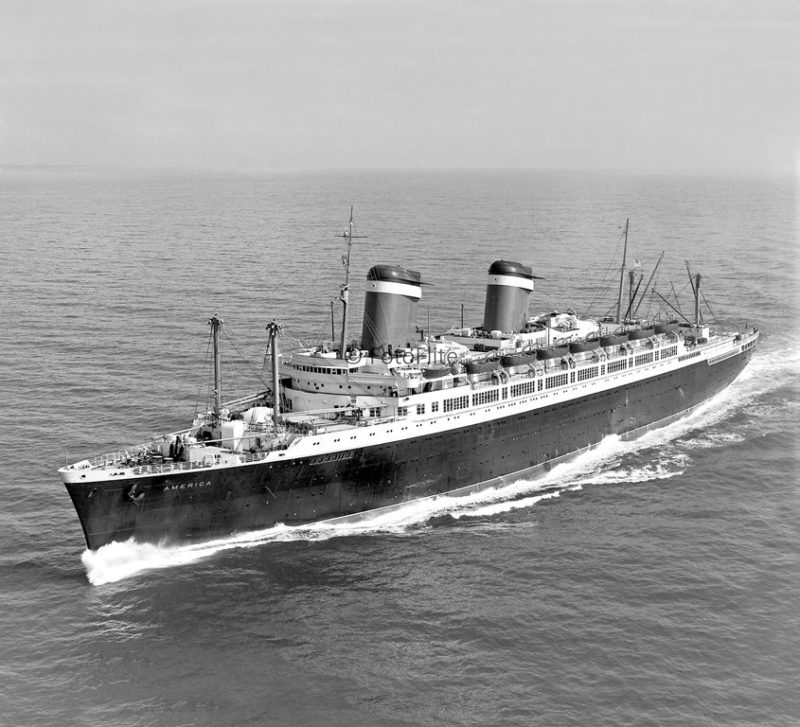
The story of the America is one that started with great hopes and ended with faded past glories. She was built to rebuild the American shipbuilding and passenger liner industries but before she could, she first served with distinction in World War Two but ended up broken and almost forgotten on a beach.
America had been created out of a need during the depression years of the 1930s to re-energise the American merchant marine which had decreased in size to a shadow of its former self during those lean times. America was to be the first ship in a 500 ship program called for under a Congressional Act passed in 1936. She was built for service with United States Lines, which had been operating their Transatlantic service with the Manhattan and Washington against stiff competition from European challengers. The situation was made worse by the passengers themselves of whom seventy out of every one hundred American passengers booked passage on foreign flagged ships rather than patronise American services most notably aboard the superliners Queen Mary and Normandie.
The design of the America was supervised by Gibbs and Cox Inc., whilst the interior design was handled by Eggers and Higgins Inc., who subcontracted the actual fitting of the plush interior to Smyth, Urquhart and Marckwald Inc. Given a clipper bow she was fast with a top speed of 22 knots. The America could carry 1,202 passengers in three classes, first, cabin and tourist. There were also areas set aside for dining rooms, smoking rooms, barber shops, a gymnasium, cocktail lounges, ballrooms and a shopping arcade. Even dogs were given special attention, the kennels were each given a sand box and a tree stump! The comfort of the fare paying passengers was of paramount importance and she was fitted with the largest air conditioning unit ever fitted to a ship up until that time.
In October 1937, the US Maritime Commission gave the $17 million contract to build the liner to Newport News Shipbuilding and Dry Dock Company of Newport News, Virginia. The keel of the new ship was laid down on 22nd August 1938 and she was launched on 31st August 1939 with the US President’s wife, Eleonor Roosevelt smashing the celebratory bottle of American champagne across the 33,532gross to ship’s bows. The ship started her journey down the slipway and in so doing became the largest American passenger ship, up to that time, to slide into the James River.
The next day across the North Atlantic Germany invaded Poland and set the world on fire with the start of World War II. On 3rd September the Anchor-Donaldson liner Athenia was torpedoed by the German submarine U-30 and sunk with the loss of 128 souls including 30 Americans. This act instantly ended the trade across the Atlantic for which the America had been built. The liner spent the next nine months alongside at Newport News finally being fitted out. America was officially completed on 16th April 1940 and on 4th June started the first of her sea trials. For these the ship had huge letters painted on her sides stating ‘America’ and ‘United States Lines’ in an effort to defend against U-boat attack and to remind their commanders of the United States neutrality. During the 24 hour run off the Virginia Capes, the America was put through exhaustive tests for steering, fuel consumption and overall performance. She returned to the shipyard the following day. She stayed alongside for the next few days before venturing to sea again on 9th for more trials en route to Boston where she was dry-docked at the Commonwealth Dock and given a fresh coat of paint. On completion she sailed north to Rockland, Maine, where she was tested on the measured mile.
The ship’s official handing over date to United States Lines had been set for 2nd July but this date slipped due to the growing conflagration in Europe and the uncertainty of when the America could be put into service. Consequently, the ship spent the best part of the month alongside. On 27th July she made her way to New York on her shakedown cruise with some 900 passengers onboard for the journey. It proved to be one they would never forget when the air conditioning system broke and temperatures across the ship rose steadily until they were near 100 degrees. Passengers were forced to strip off into just their underwear to deal with the heat. This problem was soon forgotten when the America made her maiden arrival at New York where she was welcomed in grand style. Sadly, because of the war in Europe America was now a passenger liner with nowhere to go, so instead of Europe the operators arranged a series of West Indies cruises, with the first leaving New York on 10th August 1940 taking in Havana, Port Au Prince, San Juan and St. Thomas in a 12 day itinerary. She maintained her program throughout the rest of the year and made two cruises through the Panama Canal to California.

In May 1941 her latest cruise had to be cut short when the America was ordered to return to Newport News to be refitted to serve in the US Navy as a naval auxiliary. On 15th June 1941 she was commissioned leading to speculation about her role. Some people suspected that due to her size she would be converted into a much needed aircraft carrier, but the cost and complexity of such a modification precluded this. Instead she was converted to serve in the most suitable role for the liner as the United States’ largest troop transport. The refit saw the ship painted battleship grey and anti-aircraft guns were positioned around the ship. Her luxurious interiors were removed and stored ashore replaced by extra bunks for 7,678 soldiers. In this new guise the ship was renamed as USS West Point. She was commissioned under the command of Captain Frank H. Kelley, Jr.
Her first military task was to transport 137 Italian citizens and 327 German citizens from the closed foreign consulates to Lisbon. Upon arrival in Portugal on 23rd July USS West Point embarked 321 American citizens and 67 Chinese for the return passage to New York where the ship arrived on 1st August. After tactical exercises off the Virginia Capes she sailed north to Halifax, Nova Scotia arriving on 5th November. Three days later saw the start of the embarkation of 241 officers and 5,202 men of the 55th Brigade, Bedfordshire and Hertfordshire Regiment and one hundred men of a US Army Field Service Company. On 10th November the USS West Point sailed in company with five other transport ships, Wakefield, Mount Vernon, Orizaba, Leonard Wood and Joseph T. Dickman bound for India as Convoy HS-124. For escort the ships were provided the aircraft carrier USS Ranger, cruisers USS Vincennes and USS Quincy and a division of destroyers.
At Cape Town on 9th December, USS West Point and Wakefield were detached and formed Task Group (TG) 14.1. Escorted by the heavy cruiser HMS Dorsetshire, the group arrived at Bombay where the troops were disembarked via lighters and barges due to the shallow water. As 1941 turned into 1942 USS West Point made for Singapore in company with three British transports, Duchess of Bedford, Empress of Japan and Empire Star. For protection the convoy was given the light cruisers HMS Caledon and HMS Glasgow, which was later increased by the addition of a third cruiser, HMS Exeter and four destroyers. Due to suspected Japanese submarine activity on the usual route for such large ships a more hazardous passage of the shallow Sunda Strait was arranged. HMS Exeter led the way as the ships formed a single column in line ahead to pass through the strait at 10 knots. After a fraught passage USS West Point and the other ships arrived safely at Singapore via Berhala Strait, Durian Strait and Philips Channel under bright moonlight. Singapore at this time was under daily aerial attack by Japanese aircraft and USS West Point and the other ships were anchored beyond the range of British anti-aircraft guns ashore and it was felt prudent to get them to Keppel Harbour as soon as possible to discharge their troops and cargo all whilst under aerial attack by the Japanese. Other ships were not so fortunate as a small tanker moored near Wakefield exploded and sank after being struck by a bomb. Wakefield herself was hit killing five men and wounding nine in her sickbay. The last stick of bombs from the air raid straddled USS West Point showering the ship with shrapnel.
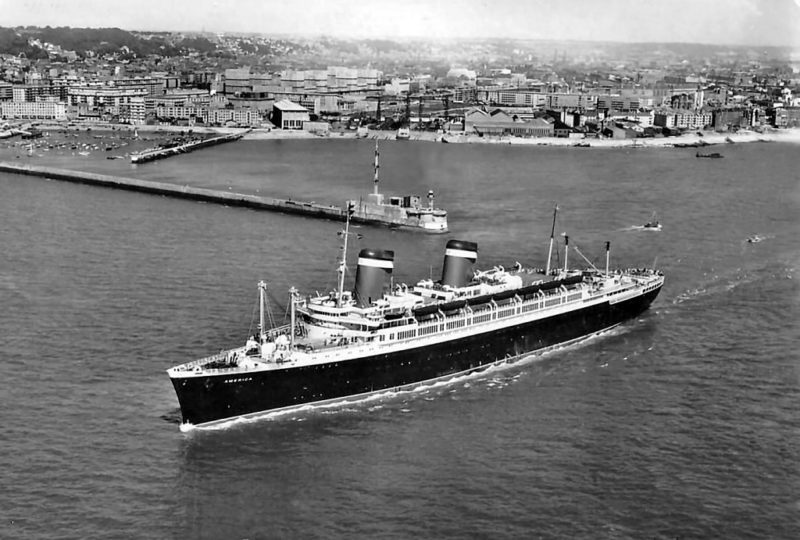
Captain Kelley was then ordered to take his ship to transport a contingent of Australian soldiers from Suez to Singapore and then take refugees and evacuees to Ceylon. The need to get citizens out of Singapore was acute and USS West Point was loaded with up to one thousand women and children along with 1,276 naval officers, their families and dockyard civilians sailed with the ship on 30th January 1942.
USS West Point was lucky, escorted by the cruiser HMS Durban, the departure was masked by squally weather and unseen by the Japanese. Routed through Batavia in Java, the group, eventually arrived at Colombo, Ceylon on 6th February. Two days earlier, USS West Point acquired an extra passenger when a baby boy was born aboard. The American transport embarked British troops plus 55 women and 53 children for passage to Bombay and sailed in company with Wakefield on 8th February under the protection of the Greek destroyer Vasilissa Olga.
From Bombay USS West Point made for Suez to embark the Australian soldiers were being redeployed from the North African campaign to fight the Japanese in Asia, but whilst on passage the unthinkable happened for the British and Singapore fell to the Japanese on 15th February, followed by Java on 4th March. The Australian troops were instead delivered to Adelaide and Melbourne. On completion USS West Point crossed the Pacific and arrived at San Francisco.
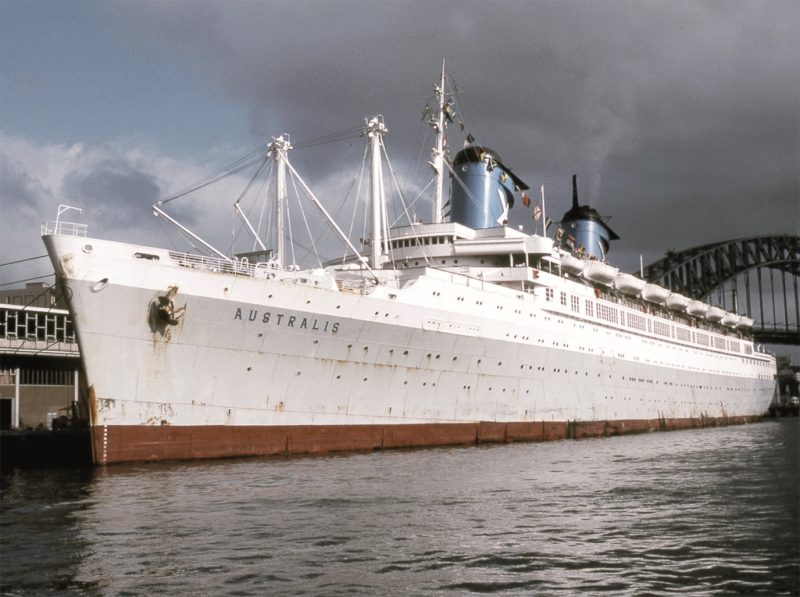
The following months saw the ship make repeated trips with massive contingents of troops to sure up Allied positions across the Pacific. On 26th June she entered the Atlantic having sailed through the Panama Canal and arrived at New York on 2nd July. From there she crossed the ocean twice with troop runs to the United Kingdom before sailing to India via the Cape of Good Hope. She arrived at Bombay on 29th November and in December arrived at Auckland in New Zealand.

In 1943 she operated mostly in the South Pacific before shifting to the Indian Ocean calling at Bombay, Massawa, Aden and Suez. From there she sailed south towards Rio de Janeiro where she narrowly avoided being torpedoed. From Brazil USS West Point made two voyages to Casablanca before, once again, returning to the Indian Ocean and towards the end of the year a return to the West Coast of the United States for the troop runs to and from Australia. The following year started with the ship supporting the American island hopping campaign across the Pacific before shifting to the North Atlantic where she made five successive voyages to the United States from June 1944 to the United Kingdom before sailing from Boston on 6th December 1944 to resupply Oran in Algeria, Casablanca in French Morocco and Marseille in France. On 26th December USS West Point took passage to Norfolk, Virginia.
With the war going the Allies way in 1945 USS West Point was utilised to bring in fresh troops to the Mediterranean theatre of operations visiting numerous French and Italian ports. On the capitulation of the Nazi regime, the transport’s huge capacity was used once more for the Magic Carpet role of repatriating American service personnel back to the United States from both the European and Pacific theatres.
Her last voyage under the name West Point was a short trip from Portsmouth to Newport News for reconversion to a passenger liner. There, six days later, she was officially decommissioned, and stricken from the Naval Vessel Register on 12th March and transferred to the Maritime Commission’s War Shipping Administration. By the late summer of 1946 USS West Point reached the end of her military service and had carried over 400,000 persons without a single loss. She was returned to the United States Line who spent $6.5 million restoring the ship to her pre war condition at Newport News Shipbuilding and Dry Dock Company. On completion of the restoration work the America, as she had been renamed, sailed out of Hampton Roads on 10th November bound for New York to begin her maiden voyage to Europe on 14th November 1946. The occasion was marked with a grand spectacle with boats and planes and fireworks to send her off. In New York for the occasion was the aircraft carriers USS Coral Sea, USS Bennington and USS Champlain who all sounded their horns for the newest ship on the North Atlantic run. The deafening send-off also saw the Grace Liner Santa Rosa join in.
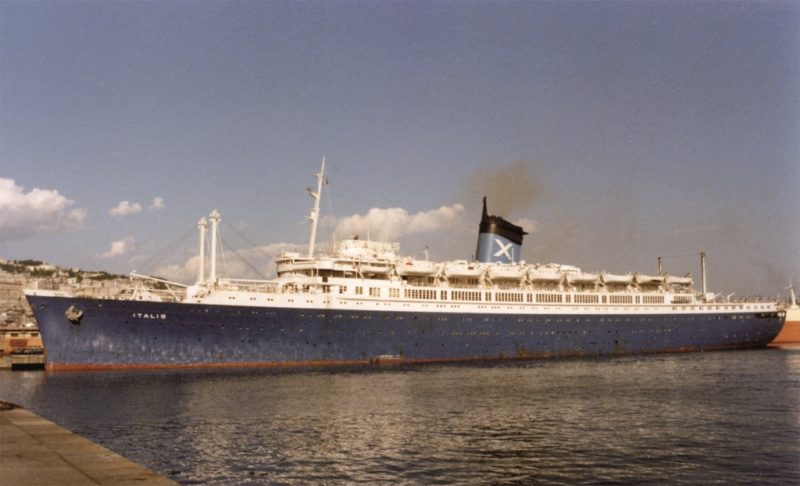
The America’s first European journey, delayed by seven years of war, saw her cross the Atlantic in a record time of 4 days, 22 hours and 22 minutes. The return trip was not so comfortable as the ship encountered severe weather conditions. So bad were the conditions that an Irish pilot who had joined the ship at Cobh, couldn’t leave the liner and made an unplanned crossing to the United States.
By 1964 the America had been in service for 24 years and was nearing the end of the Government subsidy and there was talk of her being broken up. Behind the scenes, however, talks with the Greek Chandris Shipping Company had seen them express an interest in the ship.
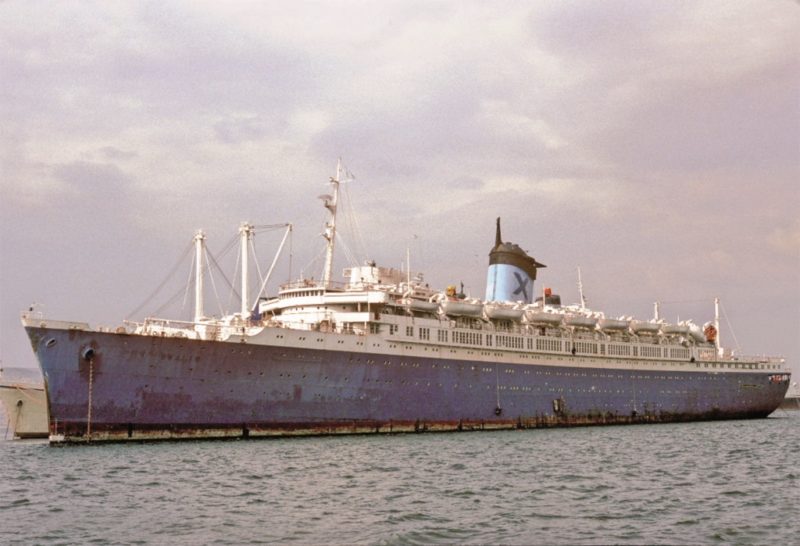
The America made her last and 286th crossing of the North Atlantic under that name on 27th October 1964 when she arrived with great fanfare at New York. Somewhat ironically, the America was berthed next to another America, the US Navy’s latest aircraft carrier USS America. On 18th November 1964 she sailed with two ‘X’s painted on her funnels and on her bows was the name Australis. Subsequently extensively refitted to increase her capacity to 2,258 passengers and given an extra 350 cabins, the Australis made her maiden voyage in August 1965 from Southampton to Australia via the Suez Canal. Over the years that followed the ship would make frequent round the world tours. On one of these on 11th July 1974 the ship was involved in a minor collision with the Royal Australian Navy’s aircraft carrier HMAS Melbourne whilst in Sydney Harbour. On 18th November 1977 Australis made her last regular run to Australia and New Zealand from Southampton. When she got to Auckland the ship was laid up at Timaru two days before Christmas 1977. After some time laid up the ship was sold on to Venture Cruise Lines of New York who, banking on the ship’s heritage, renamed her America, hoping to cash in on her history, this despite being registered as a Greek vessel. She was repainted in a blue and red colour scheme and set off on her first cruise on 30th June 1978. The cruise was a public relations disaster as the ship’s refit had not been completed properly and the ship was in a poor material condition with soiled mattresses and linen and a pungent smell from the kitchens, engine oil and bad plumbing all spoiling the passengers’ cruise experience. Such was the discontent aboard that several passengers mutinied forcing the captain to return to New York. 960 passengers were offloaded at New York, with another 200 leaving the ship via tender at Staten Island. Soon compensation claims piled up from the affected passengers which eventually totalled £2.5 million. America was subsequently impounded on 18th July 1978 for non-payment of debts. A US Public Health Service survey of the ship gave the vessel a rating of six out of a possible one hundred points. The United States District Court on 28th August 1978 ordered that the ship be sold at auction.
Chandris Lines, once again, bought the America and renamed her Italis. The ship’s age and poor maintenance had become a concern and her forward funnel, seriously corroded, was removed in an effort to modernise the ship’s silhouette. The company planned to enhance her looks by further modifying her bridge profile, but these plans were never carried out. Chandris operated Italis as a hotel ship between 23rd June and 20th July 1979 when chartered by the Organisation of African Unity Conference held in Monrovia, Liberia after which she sailed the Mediterranean until the end of the year when she was laid up in Eleusis Bay, Piraeus, Greece on 12th September 1979.
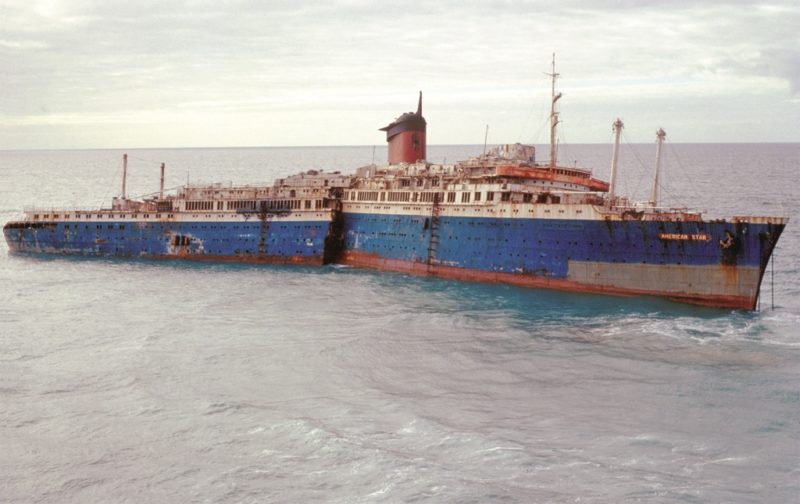
Her next name change came in 1980 when she was sold to Intercommerce Corporation and given the name Noga. The company had planned to convert the former America into a prison ship to be anchored off Beirut, but this plan never came to fruition. She languished until September 1984 when she was sold yet again, to Silver Moon Ferries and given yet another name, Alferdoss, which means paradise in Arabic. While under the ownership of Silver Moon Ferries, a burst bilge pipe led to flooding in the engine room and some crew quarters. Due to the quickly occurring list, her starboard anchor was raised, and her port anchor was cut away, and she was quickly beached to prevent her from sinking. After being pumped out and repaired, she was returned to her original location.
By now the age of the ship was of major concern and her material condition was extremely poor, in the late 1980s she was sold for scrapping for the price of $2 million. The scrap merchant had started work on taking the ship apart having paid half of the cost of the ship as a down payment. The company would default on the rest of the money and having lost her lifeboats and davits the partially dismantled ship would languish once again until 1992. In October of that year ambitious plans to refurbish the ship into a five-star hotel to be moored off Phuket in Thailand surfaced.
She was taken in hand in a drydock to assess the condition of the ship and despite years of neglect the hull was found to be in remarkably good condition. In August 1993 she was renamed as American Star and her propellers were removed and placed on display on her deck. She was repainted red and her bridge orange just for the tow to Asia. The tow started on 22nd December 1993 but ran into bad weather and returned to Greece to ride out the storm. Finally, on the last day of 1993 American Star towed by the Ukrainian tug Neftegaz-67 left Greece for the last time.
Sadly, they ran into a thunderstorm in the Atlantic and the tow lines broke. Despite frantic efforts to reattach the lines all attempts were unsuccessful and the crew aboard American Star had to be rescued by helicopter.
The former America was now adrift. At 6.15am on 18th January 1994 she ran aground at Playa de Garcey on the west coast of Fuerteventura in the Canary Islands. Within just 48 hours of her grounding the power of the waves had split the ship in two. She was declared a total loss on 6th July 1994. In 1996 the rear section of the ship collapsed into the sea and sank, while all 379ft of her bow remained tragically in view. Over the next few years the bow section also began to collapse until now only a small section of the bow and keel are visible at low tide.
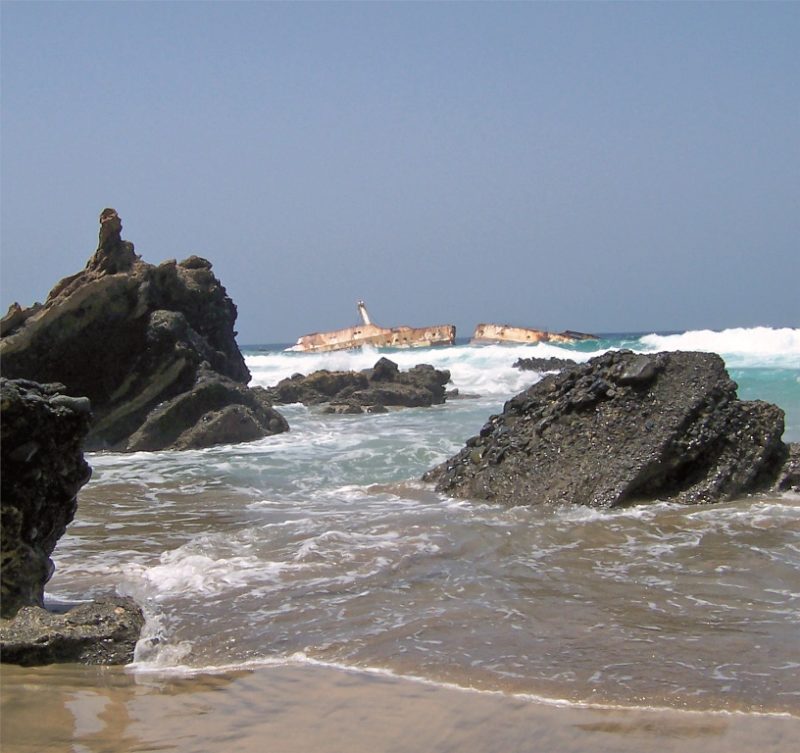

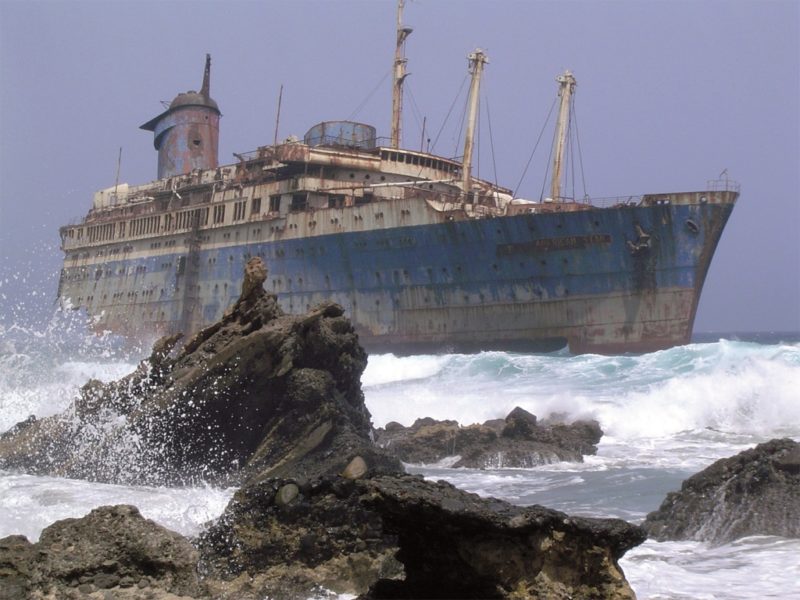
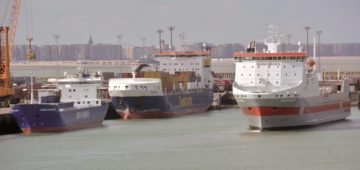



Comments
Sorry, comments are closed for this item